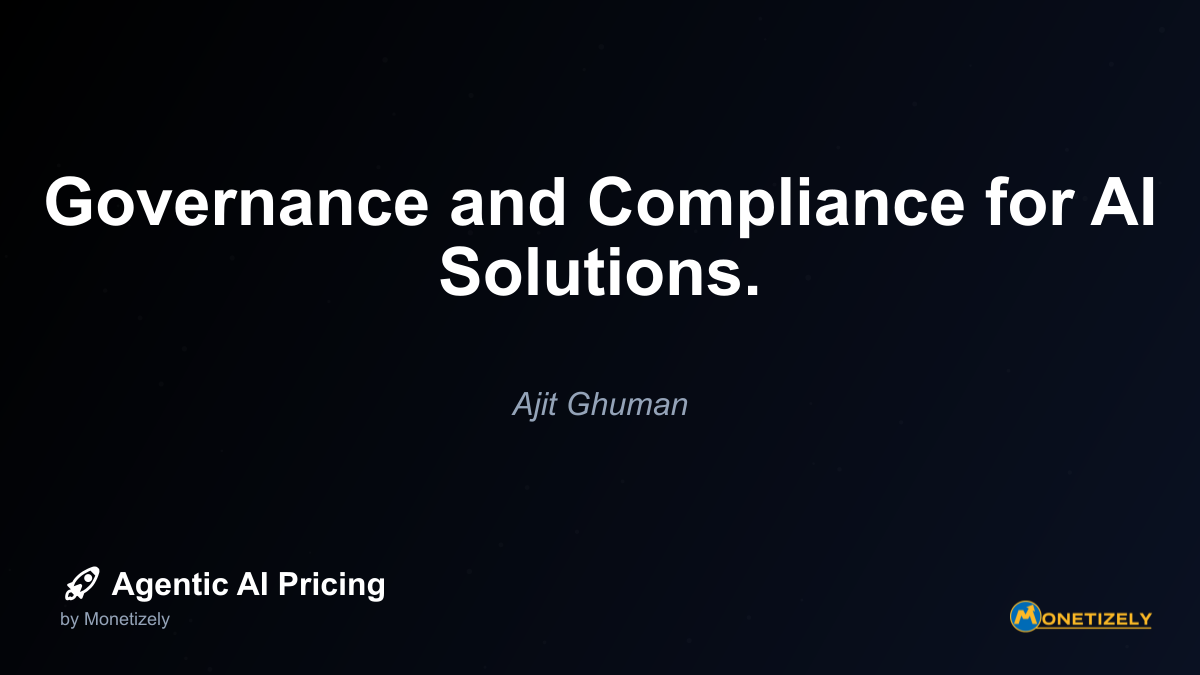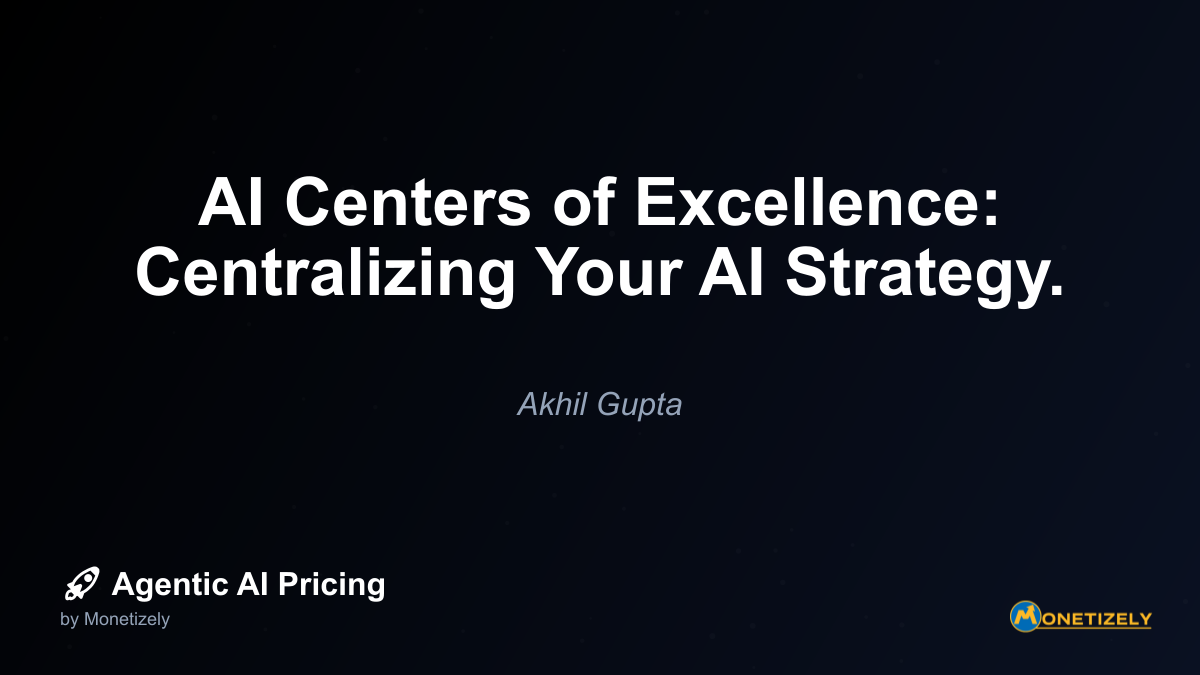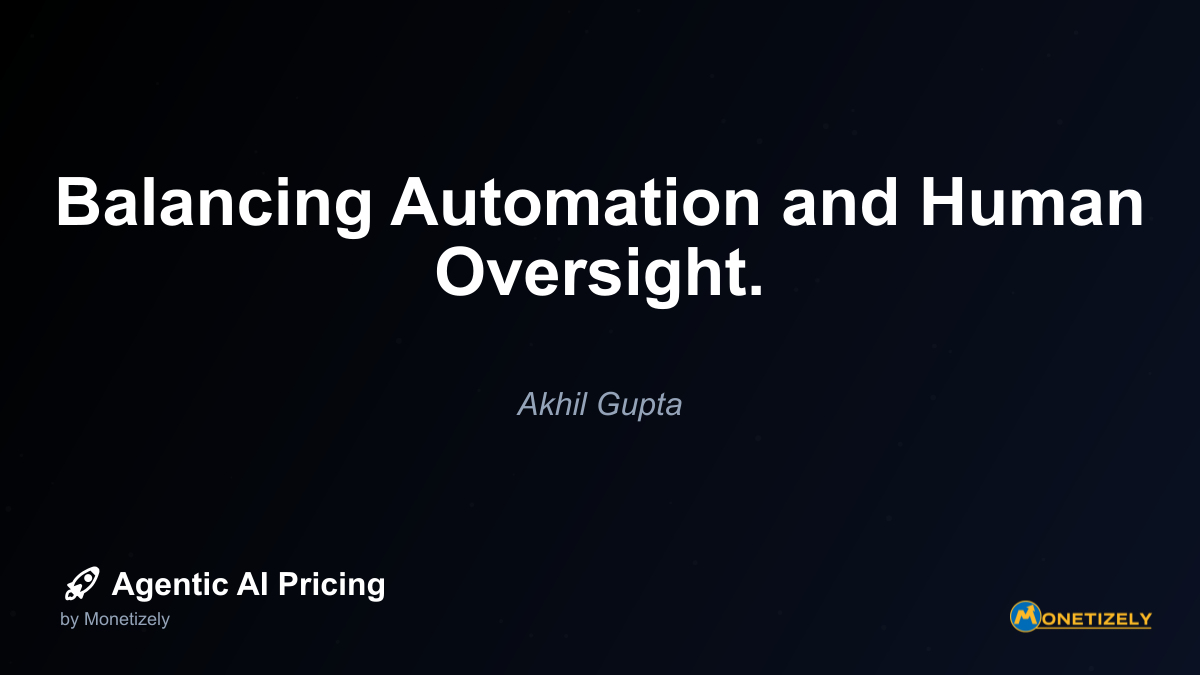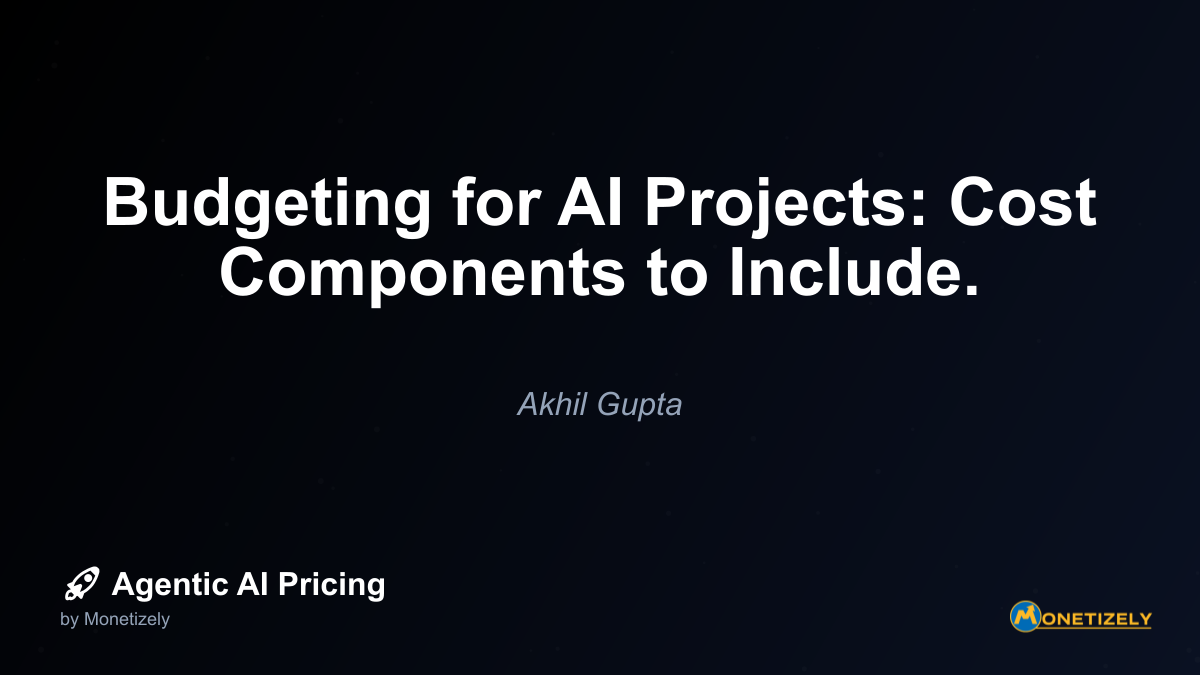· Ajit Ghuman · Implementation Strategies · 10 min read
Governance and Compliance for AI Solutions.
AI and SaaS Pricing Masterclass
Learn the art of strategic pricing directly from industry experts. Our comprehensive course provides frameworks and methodologies for optimizing your pricing strategy in the evolving AI landscape. Earn a professional certification that can be imported directly to your LinkedIn profile.

AI governance frameworks have emerged as a critical consideration for organizations deploying intelligent solutions across their operations. As autonomous systems increasingly make or influence decisions with real-world consequences, establishing robust oversight mechanisms has transitioned from a theoretical concern to an urgent business priority. Forward-thinking organizations recognize that effective governance isn’t merely about regulatory compliance—it represents a strategic advantage that builds trust, mitigates risks, and creates sustainable value.
The Growing Importance of AI Governance
The acceleration of AI capabilities has outpaced the development of corresponding governance structures. Organizations deploying agentic AI solutions face a complex landscape where technical innovation intersects with ethical considerations, regulatory requirements, and business objectives. This convergence demands a deliberate approach to governance that balances innovation with responsibility.
AI governance encompasses the policies, processes, and organizational structures that guide how artificial intelligence is developed, deployed, and monitored within an enterprise. Effective governance frameworks address questions of accountability, transparency, fairness, and compliance—establishing guardrails that promote beneficial AI use while minimizing potential harms.
For organizations implementing agentic AI pricing models, governance takes on particular significance. Pricing algorithms that dynamically respond to market conditions must operate within defined ethical boundaries and regulatory constraints. Without proper oversight, these systems risk creating unintended consequences ranging from customer backlash to regulatory penalties.
Key Components of an AI Governance Framework
A comprehensive AI governance framework should address multiple dimensions of responsible deployment. Here are the essential components organizations should consider:
1. Executive Oversight and Accountability
Effective governance begins with clear leadership accountability. Organizations should establish:
- AI Steering Committee: A cross-functional executive team responsible for setting strategic direction and policies for AI deployment
- Chief AI Ethics Officer: A designated executive with direct responsibility for ethical AI implementation
- Board-Level Reporting: Regular updates to the board on AI initiatives, risks, and compliance status
The governance structure should clearly delineate decision-making authority and escalation paths for AI-related issues. This includes defining who can approve new AI applications, who monitors ongoing performance, and who has authority to modify or decommission problematic systems.
2. Ethical Guidelines and Principles
Organizations need clearly articulated ethical principles that guide AI development and deployment. These principles should:
- Reflect organizational values and industry best practices
- Address fairness, transparency, privacy, and security
- Provide practical guidance for implementation teams
- Include specific considerations for pricing applications
Major technology companies and industry consortia have published AI ethics frameworks that can serve as starting points. However, organizations should customize these guidelines to reflect their specific context, risk profile, and business objectives.
3. Risk Assessment and Management Processes
AI governance requires systematic risk assessment throughout the solution lifecycle:
- Pre-deployment assessment: Evaluating potential risks before implementation
- Continuous monitoring: Ongoing assessment during operation
- Periodic reviews: Scheduled comprehensive evaluations
- Incident response: Protocols for addressing unexpected behavior
For pricing applications, risk assessments should specifically consider market impacts, customer perception, competitive responses, and potential discrimination or fairness concerns. Organizations should develop risk registers that categorize AI applications based on their potential impact and establish proportionate controls.
4. Regulatory Compliance Mechanisms
AI solutions must operate within applicable regulatory frameworks, which may include:
- Data protection regulations (GDPR, CCPA, etc.)
- Industry-specific requirements (financial services, healthcare, etc.)
- Consumer protection laws
- Emerging AI-specific regulations
Compliance mechanisms should include processes for tracking regulatory developments, assessing their implications for AI systems, and implementing necessary controls. This requires close collaboration between legal, compliance, and technical teams.
Building an AI Governance Committee
A dedicated governance committee serves as the operational center of an effective oversight framework. This cross-functional team should include representation from:
- Executive leadership
- Legal and compliance
- Data science and AI development
- Risk management
- Business units using AI solutions
- Information security
- Ethics specialists
The committee’s responsibilities typically include:
- Reviewing and approving new AI applications
- Establishing and updating policies and standards
- Monitoring compliance with internal and external requirements
- Addressing ethical concerns and conflicts
- Overseeing training and awareness programs
- Reporting to senior leadership and the board
For organizations implementing agentic AI pricing, the governance committee should include pricing strategy experts who understand both the technical aspects of algorithmic pricing and the market implications of different approaches.
Implementing Ethical Guidelines for AI
Ethical guidelines provide the foundation for responsible AI development and deployment. Effective guidelines should address:
Fairness and Non-Discrimination
AI systems, particularly those involved in pricing decisions, must avoid perpetuating or amplifying biases. Organizations should:
- Establish clear definitions of fairness appropriate to their context
- Implement testing protocols to identify potential discrimination
- Monitor outcomes across different customer segments
- Create remediation processes for addressing identified issues
For pricing applications, this includes ensuring that algorithmic decisions don’t disproportionately impact vulnerable populations or create unintended discriminatory effects.
Transparency and Explainability
Organizations should establish standards for AI transparency that address:
- What information about AI systems should be disclosed to different stakeholders
- How complex algorithmic decisions can be explained in understandable terms
- Documentation requirements for AI development and deployment
- Processes for responding to inquiries about AI-driven decisions
For pricing applications, this might include the ability to explain why a particular customer received a specific price point or how dynamic pricing algorithms respond to market conditions.
Privacy and Data Governance
AI systems often rely on extensive data, raising important privacy considerations:
- Data minimization principles (collecting only necessary data)
- Consent mechanisms for data collection and use
- Data retention and deletion policies
- Access controls and security measures
- Data quality and accuracy standards
Organizations should establish clear data governance processes that address the entire lifecycle of information used in AI systems, from collection through processing to eventual disposal.
Human Oversight and Intervention
Even autonomous systems require human oversight. Guidelines should address:
- When human review of AI decisions is required
- Who has authority to override algorithmic recommendations
- How to maintain meaningful human control over AI systems
- Training requirements for those supervising AI applications
For pricing systems, this might include establishing thresholds for price changes that trigger human review or creating exception processes for unusual market conditions.
Regulatory Compliance for AI Solutions
The regulatory landscape for AI continues to evolve rapidly. Organizations must navigate requirements that vary by jurisdiction, industry, and application type. Key regulatory considerations include:
Data Protection and Privacy Regulations
AI systems that process personal data must comply with regulations like:
- General Data Protection Regulation (GDPR): Imposes strict requirements for processing personal data in the EU, including limitations on automated decision-making
- California Consumer Privacy Act (CCPA): Provides California residents with rights regarding their personal information
- Industry-specific regulations: Such as HIPAA for healthcare data
Compliance with these regulations requires implementing technical and organizational measures that address:
- Legal basis for data processing
- Data subject rights (access, correction, deletion, etc.)
- Data protection impact assessments
- Cross-border data transfer restrictions
- Breach notification requirements
Emerging AI-Specific Regulations
Jurisdictions around the world are developing AI-specific regulatory frameworks:
- EU AI Act: Proposes a risk-based approach to regulating AI systems
- US AI Bill of Rights: Outlines principles for responsible AI development
- Canada’s Artificial Intelligence and Data Act: Establishes requirements for high-impact AI systems
Organizations should establish processes for monitoring these regulatory developments and assessing their implications for AI deployments.
Industry-Specific Requirements
Many industries have specific regulations that impact AI applications:
- Financial services: Requirements for algorithmic trading, credit decisions, and fraud detection
- Healthcare: Regulations governing medical devices and clinical decision support
- Transportation: Safety standards for autonomous systems
Organizations should identify industry-specific requirements applicable to their AI solutions and implement appropriate compliance measures.
Implementing Compliance Checks for AI Systems
Ensuring ongoing compliance requires systematic verification processes throughout the AI lifecycle:
Pre-Implementation Assessment
Before deploying AI solutions, organizations should conduct comprehensive compliance assessments:
- Data protection impact assessment: Evaluating privacy implications and implementing necessary safeguards
- Algorithmic impact assessment: Analyzing potential effects on individuals and groups
- Regulatory compliance review: Ensuring alignment with applicable regulations
- Ethics review: Assessing consistency with organizational values and ethical principles
These assessments should be documented and reviewed by appropriate governance bodies before implementation approval.
Continuous Monitoring
Once deployed, AI systems require ongoing compliance monitoring:
- Regular audits of system behavior and outcomes
- Automated monitoring for drift or unexpected patterns
- Performance tracking against fairness metrics
- Periodic reassessment as regulations evolve
Organizations should establish key performance indicators for compliance and ethics, with regular reporting to governance committees and leadership.
Documentation and Evidence
Maintaining comprehensive documentation provides evidence of compliance efforts:
- Design documents explaining system architecture and decision logic
- Testing results demonstrating compliance with requirements
- Risk assessments and mitigation strategies
- Training records for team members
- Audit trails of system behavior and human interventions
This documentation serves both internal governance purposes and may be required for external regulatory reviews.
Practical Implementation Strategies for AI Governance
Implementing effective governance requires practical strategies that balance control with innovation:
1. Adopt a Risk-Based Approach
Not all AI applications carry the same level of risk. Organizations should:
- Categorize AI systems based on potential impact
- Apply governance controls proportionate to risk level
- Focus intensive oversight on high-risk applications
- Create streamlined processes for lower-risk systems
This approach ensures that governance resources are allocated efficiently and innovation isn’t unnecessarily constrained.
2. Integrate Governance Throughout the AI Lifecycle
Governance shouldn’t be an afterthought. Organizations should:
- Incorporate ethical considerations during initial concept development
- Build compliance requirements into design specifications
- Implement testing protocols that verify alignment with governance standards
- Establish monitoring mechanisms for deployed systems
- Create feedback loops between operations and governance
This “governance by design” approach is more effective than attempting to retrofit controls onto existing systems.
3. Develop Specialized Expertise
Effective governance requires specialized knowledge. Organizations should:
- Invest in training for governance committee members
- Consider hiring AI ethics specialists
- Engage external experts for complex issues
- Create communities of practice to share knowledge
This expertise development should extend beyond technical teams to include business leaders who make decisions about AI deployment.
4. Establish Clear Incident Response Procedures
When AI systems behave unexpectedly, organizations need defined response protocols:
- Criteria for identifying AI incidents
- Escalation paths based on severity
- Investigation procedures
- Remediation approaches
- Stakeholder communication plans
- Documentation requirements
These procedures should be tested regularly through tabletop exercises or simulations.
Governance Considerations for Agentic AI Pricing
Pricing applications present unique governance challenges due to their direct impact on customers and markets. Organizations implementing agentic AI pricing should consider these specific governance elements:
Market Impact Assessment
Before implementing algorithmic pricing, organizations should assess potential market effects:
- Impact on different customer segments
- Competitive responses
- Potential for unintended consequences (e.g., price spirals)
- Alignment with brand positioning and customer expectations
This assessment should inform both technical implementation and governance controls.
Transparency Guidelines
Organizations should establish clear policies regarding pricing transparency:
- What information about pricing algorithms will be disclosed to customers
- How price recommendations can be explained to internal stakeholders
- Documentation requirements for pricing models
- Processes for responding to customer inquiries about pricing
These guidelines help maintain trust while protecting legitimate business interests.
Human Oversight Protocols
Even autonomous pricing systems require appropriate human supervision:
- Thresholds for price changes that trigger review
- Approval processes for algorithm modifications
- Monitoring dashboards for pricing managers
- Override capabilities for exceptional circumstances
These protocols ensure that pricing remains aligned with broader business strategy and values.
Building a Culture of Responsible AI
Governance frameworks are necessary but insufficient without a supporting organizational culture. Leaders should focus on:
Executive Commitment
Senior leadership must demonstrate visible commitment to responsible AI:
- Publicly championing ethical principles
- Allocating resources to governance activities
- Recognizing and rewarding responsible practices
- Addressing governance concerns promptly
This commitment signals that ethics and compliance are core organizational priorities.
Training and Awareness
Organizations should invest in comprehensive training programs:
- General AI literacy for all employees
- Specialized ethics training for technical teams
- Governance process training for relevant stakeholders
- Regular updates on regulatory developments
These programs build the knowledge foundation necessary for effective governance.
Incentive Alignment
Performance metrics and incentives should support responsible AI:
- Including ethics considerations in performance reviews
- Recognizing contributions to governance improvements
- Avoiding incentives that encourage cutting corners
- Creating consequences for governance violations
This alignment ensures that individual motivations support organizational governance objectives.
Conclusion
Establishing effective governance and compliance frameworks for AI solutions is no longer optional—it’s a business imperative. Organizations that implement robust oversight mechanisms position themselves to capture the benefits of AI while managing associated risks. This balanced approach builds trust with customers, regulators, and other stakeholders while creating sustainable competitive advantage.
For organizations implementing agentic AI pricing solutions, governance takes on particular importance given the direct impact on customer relationships and market dynamics. By establishing clear accountability structures, ethical guidelines, risk management processes, and compliance mechanisms, organizations create the foundation for responsible innovation in pricing and beyond.
As AI capabilities continue to advance, governance frameworks will need to evolve accordingly. Organizations that build flexible, principles-based governance systems—rather than rigid rule sets—will be better positioned to adapt to changing technologies and regulatory requirements. By investing in governance today, organizations create the conditions for responsible AI innovation tomorrow.
Co-Founder & CEO
Ajit is the author of Price To Scale, a top book on SaaS Pricing and is the Founder of Monetizely. Ajit has led and worked in pricing and product marketing at firms like Twilio, Narvar and Medallia. His work has been featured in Forbes and VentureBeat. Ajit regularly consults with software companies from Seed stage to post-IPO on pricing strategy. Ajit is also a highly-rated co-instructor for 'The Art of SaaS Pricing and Monetization' on Maven.
Pricing Strategy Audit
Let our experts analyze your current pricing strategy and identify opportunities for improvement. Our data-driven assessment will help you unlock untapped revenue potential and optimize your AI pricing approach.




